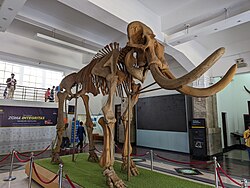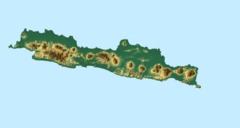Biology:Elephas hysudrindicus
| Elephas hysudrindicus Temporal range: Pleistocene
| |
|---|---|

| |
| Elephas hysudrindicus in the Bandung Geological Museum | |
| Scientific classification | |
| Domain: | Eukaryota |
| Kingdom: | Animalia |
| Phylum: | Chordata |
| Class: | Mammalia |
| Order: | Proboscidea |
| Family: | Elephantidae |
| Genus: | Elephas |
| Species: | †E. hysudrindicus
|
| Binomial name | |
| †Elephas hysudrindicus Dubois, 1908
| |
| Sunggun Archaeological Site in Blora, Java | |
Elephas hysudrindicus, commonly known also as the Blora elephant in Indonesia (lit. Gajah Blora in Indonesian), is a species of extinct elephant from the Pleistocene of Java. It is anatomically distinct from the Asian elephant, the last remaining species of elephant under the genus Elephas.[1][2] The species existed from around the end of the Early Pleistocene until the end of the Middle Pleistocene, when it was replaced by the modern Asian elephant, coexisting alongside fellow proboscidean Stegodon trigonocephalus, as well archaic humans belonging to the species Homo erectus.[3][4]
Taxonomy
When Alphonse Dubois described the species in 1908, he failed to designate a holotype specimen. In 2017, the partial skull RGM.DUB 4968–4969 in the collections of the Naturalis Biodiversity Center, Leiden was designated the lectotype.[2] It is considered to be closely related to the extinct Elephas hysudricus of mainland Asia,[5] which it is possibly descended from.[6]
A fossil was excavated from Sunggun archaeological site, Medalem, Kradenan Subregency, Blora in March 2009. It was found almost completely intact (estimating about 90%) about a few feet under the dirt in a former sand quarry in the village.[7][8] It was then brought to the Bandung Geological Museum which was then put to display.[9]
Ecology
Isotopic analysis suggests a primarily C4 grazing dominated diet, similar to that inferred for Stegodon trigonocephalus, suggesting that they occupied open habitats on the island.[3]
References
- ↑ Hooijer, D. A. (1955). Fossil Proboscidea from the Malay Archipelago and the Punjab. Zoologische Verhandelingen, 28 (1): 1–146.
- ↑ 2.0 2.1 Zhang, Hanwen; Pape, Thomas; Lister, Adrian M. (2018-01-02). "On the type material of Elephas hysudrindicus Dubois, 1908 (Mammalia, Proboscidea)" (in en). Journal of Vertebrate Paleontology 38 (1): e1425211. doi:10.1080/02724634.2017.1425211. ISSN 0272-4634. Bibcode: 2018JVPal..38E5211Z. https://www.tandfonline.com/doi/full/10.1080/02724634.2017.1425211.
- ↑ 3.0 3.1 Puspaningrum, Mika R.; van den Bergh, Gerrit D.; Chivas, Allan R.; Setiabudi, Erick; Kurniawan, Iwan (January 2020). "Isotopic reconstruction of Proboscidean habitats and diets on Java since the Early Pleistocene: Implications for adaptation and extinction" (in en). Quaternary Science Reviews 228: 106007. doi:10.1016/j.quascirev.2019.106007. Bibcode: 2020QSRv..22806007P. https://linkinghub.elsevier.com/retrieve/pii/S0277379119303178.
- ↑ Rizal, Yan; Westaway, Kira E.; Zaim, Yahdi; van den Bergh, Gerrit D.; Bettis, E. Arthur; Morwood, Michael J.; Huffman, O. Frank; Grün, Rainer et al. (2020-01-16). "Last appearance of Homo erectus at Ngandong, Java, 117,000–108,000 years ago" (in en). Nature 577 (7790): 381–385. doi:10.1038/s41586-019-1863-2. ISSN 0028-0836. PMID 31853068. https://www.nature.com/articles/s41586-019-1863-2.
- ↑ Lister, Adrian M.; Dirks, Wendy; Assaf, Amnon; Chazan, Michael; Goldberg, Paul; Applbaum, Yaakov H.; Greenbaum, Nathalie; Horwitz, Liora Kolska (September 2013). "New fossil remains of Elephas from the southern Levant: Implications for the evolutionary history of the Asian elephant" (in en). Palaeogeography, Palaeoclimatology, Palaeoecology 386: 119–130. doi:10.1016/j.palaeo.2013.05.013. Bibcode: 2013PPP...386..119L. https://linkinghub.elsevier.com/retrieve/pii/S003101821300237X.
- ↑ Vidya, T.N.C; Sukumar, Raman; Melnick, Don J (2009-03-07). "Range-wide mtDNA phylogeography yields insights into the origins of Asian elephants" (in en). Proceedings of the Royal Society B: Biological Sciences 276 (1658): 893–902. doi:10.1098/rspb.2008.1494. ISSN 0962-8452. PMID 19019786.
- ↑ webadmin. "Replika Fosil Gajah Purba Blora Bisa Dikunjungi Setiap Hari" (in en). https://www.blorakab.go.id/index.php/public/berita/detail/1002/replika-fosil-gajah-purba-blora-bisa-dikunjungi-setiap-hari.
- ↑ "Fossils of prehistoric elephant, leaf found in Blora This article was published in thejakartapost.com with the title " Fossils of prehistoric elephant, leaf found in Blora". 23 April 2009. https://www.thejakartapost.com/news/2009/04/23/fossils-prehistoric-elephant-leaf-found-blora.html.
- ↑ "Museum gets pre-historic elephant bones". The Jakarta Post. https://www.thejakartapost.com/news/2009/04/11/museum-gets-prehistoric-elephant-bones.html.
Wikidata ☰ Q5359441 entry
 |


